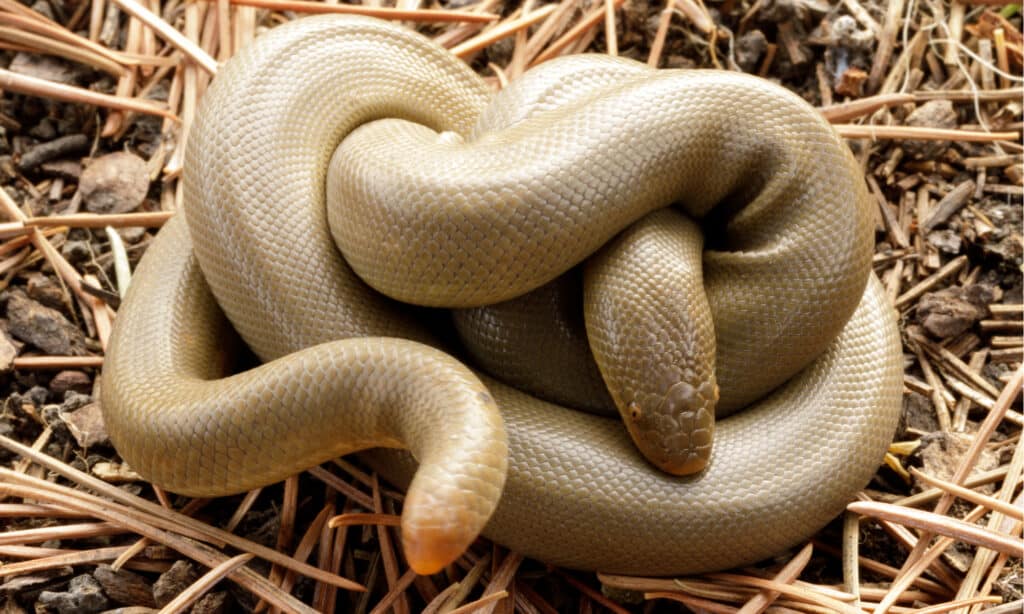Rubber Boa
Charina bottae
Rubber boas are one of North America’s only boa species.
Advertisement
Rubber Boa Scientific Classification

Rubber Boa Facts
- Prey
- Lizards, rodents
- Group Behavior
- Solitary
- Solitary except during mating season
- Fun Fact
- Rubber boas are one of North America’s only boa species.
- Diet for this Fish
- Carnivore
- Average Litter Size
- 1-5 babies
- Lifestyle
- Nocturnal
- Common Name
- Rubber boa
- Special Features
- Solid brown, yellow belly with brown spots
View all of the Rubber Boa images!
Summary
“Rubber boas are sometimes called two-headed snakes”
The rubber boa has a glossy covering of brownish yellow scales. They can live in a forest, grassland, or mountain habitat. They are carnivores with a diet of rodents, small bats, small birds, and snake eggs. There’s a northern species of rubber boa as well as a southern species. These are non-aggressive snakes found hiding under rocks, leaf piles and in burrows.
4 Rubber Boa Amazing Facts
- It can swim and climb trees with ease
- It can tolerate colder temperatures better than other types of snakes
- It wraps around prey to subdue it
- With the right kind of care, this reptile can be kept as a pet
Where to Find a Rubber Boa
The rubber boa lives in the United States and Canada. In the United States the Northern rubber boa lives in Wyoming, Utah, Nevada, Washington, Montana, and California. The northern species also lives in British Columbia in Canada. The Southern rubber boa lives in southern California.
Their habitat includes grasslands, forests, meadows, and mountain areas. They are found in a warm, moist environment.
One surprising thing about this snake is it can live in colder temperatures. In fact, it’s been found in an environment of 54 degrees Fahrenheit. This is on the colder side for a snake!
If the temperature becomes too hot or too cold, these snakes retire into underground burrows or inside hollow logs. They are sometimes found basking on rocks in the sunlight to warm up.
Though they can endure colder temperatures, rubber boas go into brumation in the wintertime. They become active again in the spring for breeding season. Rubber boas give live birth to their young beginning in August into late November.
These snakes are challenging to find because they spend a lot of time hiding under leaf litter, rocks, or logs.
Types of Rubber Boas
These two types of rubber boas are in the Boidae family. They are both found in the United States, but one has a larger range than the other.
- Northern rubber boa (Charina bottae)-This species lives in the northern and western section of the United States including Montana, Wyoming, Utah, and California. It is listed as Least Concern with a growing population.
- Southern rubber boa (Charina umbratica)-This rubber boa species looks very similar to the northern species, but the northern species is longer in size. However, it’s only found in a section of southern California. The Southern rubber boa is categorized as Vulnerable with a falling population. It’s threatened by loss of habitat due to construction as well as steady loss of its food supply.
Rubber Boa Scientific Name
Charina bottae is the scientific name of the rubber boa. It’s sometimes called the coastal rubber boa. The Greek word Charina means graceful and the word bottae refers to a well-known naturalist named Paolo Botta.
Its family is Boidae, and class is Reptilia.
The species of this snake are:
- Charina bottae
- Charina umbratica
Rubber Boa Population and Conservation Status
The population of the Northern rubber boa is 100,000 plus mature adults. According to the IUCN Red List, they are listed as Least Concern with a population described as stable.
The Southern rubber boa is listed as Vulnerable with a decreasing population. Though the exact number of Southern rubber boas is unknown, scientists estimate the existence of just a few thousand of them.
How to Identify a Rubber Boa: Appearance and Description
A rubber boa has brownish yellow scales on its back and yellow or white scales on its belly with brown spots. Its scales have a glossy sheen and there is a rubbery feel to its skin. This is how they got the name rubber boa.
It has small dark eyes that blend in with the overall color of its scales.
When it comes to size, this snake has a uniformly thick body. Its head is the same thickness as its tail. This is why it’s sometimes referred to as the two-headed snake.
An adult rubber boa is 14 to 33 inches in length. They weigh less than three ounces.

A coiled Northern Rubber Boa
©yhelfman/Shutterstock.com
How to Identify Rubber Boa Snakes
- Brownish yellow scales on its back
- Glossy scales with a loose, rubbery texture
- A white or yellow belly sprinkled with brown spots
- A uniformly thick body with a head and tail that are the same size
Rubber Boa: How Dangerous Are They?
Rubber boas are non-venomous. Though they have teeth, they are not aggressive snakes and unlikely to bite. Generally, they don’t use their teeth as a defense.
As an example, these snakes are known to consume entire nests of baby mice or other rodents. If the mother rodent tries to attack the snake in order to defend her young, the rubber boa whips its tail around to push the female mouse away. This is the reason why rubber boas are known to have scars and nicks on their tails.
But, of course a rubber boa has the ability to bite a person if it feels driven into a corner. Its teeth are small and its bite is not painful. Its bite has been described as a sensation similar to the prick of a needle.
If a bite does occur, the area should be thoroughly cleaned with soap and water. It’s important to put first-aid ointment on the bite area in an effort to prevent infection. If the area becomes extremely red or a rash develops, it’s a good idea to see a doctor.
Rubber Boa Behavior and Humans
Rubber boas are not considered pests. This is a shy snake that stays hidden in its habitat beneath leaf litter, in hollow logs or even in abandoned rodent burrows.
They are non-venomous and not a threat to humans. Just the opposite! They eat rodents like mice that can quickly become pests in a household.
Similar Animals
View all 114 animals that start with RRubber Boa FAQs (Frequently Asked Questions)
What is a rubber boa?
A rubber boa is a smaller member of the Boidae family. It has dark brownish yellow scales on its back and yellow or white scales on its belly. Sometimes it has brown spots on its belly as well.
It is 14 to 33 inches in size and weighs less than three ounces. Its body is uniformly thick with a head and tail the same size. As a note, having a head and a tail that are the same size can confuse predators giving a rubber boa the opportunity to get away.
Rubber boas live in the northern and western parts of the United States as well as in Canada. They have a grassland, meadow, forest, or mountain habitat.
Are rubber boas venomous?
No, rubber boas are non-venomous.
How do rubber boas hunt?
A rubber boa searches for its prey of rodents, lizards, or small birds. It grabs its prey and coils its body around it. A rubber boa is a constrictor snake like its relatives the boa constrictor and green anaconda. It squeezes its prey until it’s dead.
Rubber boas also eat eggs and baby rodents. They steal them out of nests to eat them.
Are rubber boas aggressive?
No, these snakes are not aggressive. When confronted, they slither away to hide beneath a pile of leaf litter or in a hollow log rather than face the threat.
Where do rubber boas live?
Rubber boas live in the United States and the southern part of Canada.
What do rubber boas eat?
They eat adult rodents, bird eggs, baby rodents, and lizards.
Why is it called a rubber boa?
This snake’s scales have a glossy sheen with a rubbery texture. Some people describe their scales as having a velvety feel.
Are rubber boas friendly?
Yes. In fact, they are considered timid snakes. Some people keep these snakes as pets because they are non-aggressive.
Of course, an owner should learn how to give this snake the right type of care to keep it healthy.
How rare is a rubber boa?
A Northern rubber boa is not rare. It has a plentiful population. On the other hand, the Southern rubber boa is considered Vulnerable with a decreasing population.
How long do rubber boas live?
Their lifespan is 12 to 25 years. Some pet rubber boa snakes live longer than 25 years if they receive the proper type of care.
Thank you for reading! Have some feedback for us? Contact the AZ Animals editorial team.
Sources
- (1970) https://curiodyssey.org/animals/our-animals/reptiles/rubber-boa/ https://www.iucnredlist.org/species/91863316/18978274 http://www.californiaherps.com/snakes/pages/c.umbratica.html https://en.wikipedia.org/wiki/Rubber_boa https://happyserpent.com/snake-profile/rubber-boa/ https://wdfw.wa.gov/species-habitats/species/charina-bottae#desc-range https://www.nps.gov/yell/learn/nature/rubber-boa.htm https://en.wikipedia.org/wiki/Boa_constrictor

















